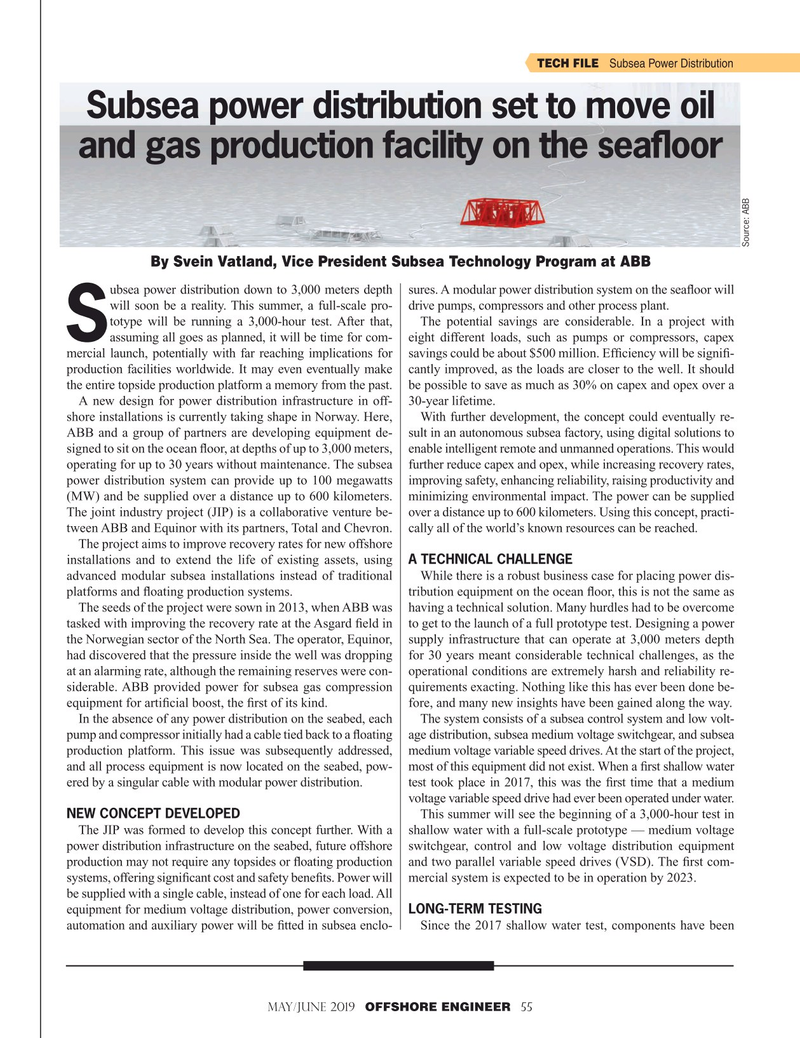
Page 55: of Offshore Engineer Magazine (May/Jun 2019)
Offshore Renewables Review
Read this page in Pdf, Flash or Html5 edition of May/Jun 2019 Offshore Engineer Magazine
TECH FILE Subsea Power Distribution
Subsea power distribution set to move oil and gas production facility on the sea? oor
Source: ABB
By Svein Vatland, Vice President Subsea Technology Program at ABB ubsea power distribution down to 3,000 meters depth sures. A modular power distribution system on the sea? oor will will soon be a reality. This summer, a full-scale pro- drive pumps, compressors and other process plant.
totype will be running a 3,000-hour test. After that, The potential savings are considerable. In a project with
Sassuming all goes as planned, it will be time for com- eight different loads, such as pumps or compressors, capex mercial launch, potentially with far reaching implications for savings could be about $500 million. Ef? ciency will be signi? - production facilities worldwide. It may even eventually make cantly improved, as the loads are closer to the well. It should the entire topside production platform a memory from the past. be possible to save as much as 30% on capex and opex over a
A new design for power distribution infrastructure in off- 30-year lifetime.
shore installations is currently taking shape in Norway. Here, With further development, the concept could eventually re-
ABB and a group of partners are developing equipment de- sult in an autonomous subsea factory, using digital solutions to signed to sit on the ocean ? oor, at depths of up to 3,000 meters, enable intelligent remote and unmanned operations. This would operating for up to 30 years without maintenance. The subsea further reduce capex and opex, while increasing recovery rates, power distribution system can provide up to 100 megawatts improving safety, enhancing reliability, raising productivity and (MW) and be supplied over a distance up to 600 kilometers. minimizing environmental impact. The power can be supplied
The joint industry project (JIP) is a collaborative venture be- over a distance up to 600 kilometers. Using this concept, practi- tween ABB and Equinor with its partners, Total and Chevron. cally all of the world’s known resources can be reached.
The project aims to improve recovery rates for new offshore installations and to extend the life of existing assets, using A TECHNICAL CHALLENGE advanced modular subsea installations instead of traditional While there is a robust business case for placing power dis- platforms and ? oating production systems. tribution equipment on the ocean ? oor, this is not the same as
The seeds of the project were sown in 2013, when ABB was having a technical solution. Many hurdles had to be overcome tasked with improving the recovery rate at the Asgard ? eld in to get to the launch of a full prototype test. Designing a power the Norwegian sector of the North Sea. The operator, Equinor, supply infrastructure that can operate at 3,000 meters depth had discovered that the pressure inside the well was dropping for 30 years meant considerable technical challenges, as the at an alarming rate, although the remaining reserves were con- operational conditions are extremely harsh and reliability re- siderable. ABB provided power for subsea gas compression quirements exacting. Nothing like this has ever been done be- equipment for arti? cial boost, the ? rst of its kind. fore, and many new insights have been gained along the way.
In the absence of any power distribution on the seabed, each The system consists of a subsea control system and low volt- pump and compressor initially had a cable tied back to a ? oating age distribution, subsea medium voltage switchgear, and subsea production platform. This issue was subsequently addressed, medium voltage variable speed drives. At the start of the project, and all process equipment is now located on the seabed, pow- most of this equipment did not exist. When a ? rst shallow water ered by a singular cable with modular power distribution. test took place in 2017, this was the ? rst time that a medium voltage variable speed drive had ever been operated under water.
NEW CONCEPT DEVELOPED This summer will see the beginning of a 3,000-hour test in
The JIP was formed to develop this concept further. With a shallow water with a full-scale prototype — medium voltage power distribution infrastructure on the seabed, future offshore switchgear, control and low voltage distribution equipment production may not require any topsides or ? oating production and two parallel variable speed drives (VSD). The ? rst com- systems, offering signi? cant cost and safety bene? ts. Power will mercial system is expected to be in operation by 2023. be supplied with a single cable, instead of one for each load. All equipment for medium voltage distribution, power conversion, LONG-TERM TESTING automation and auxiliary power will be ? tted in subsea enclo- Since the 2017 shallow water test, components have been
MAY/JUNE 2019 OFFSHORE ENGINEER 55 50-64 OE MayJune 2019.indd 55 6/10/2019 10:28:15 AM

 54
54

 56
56